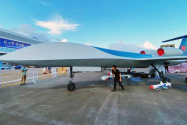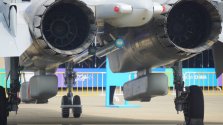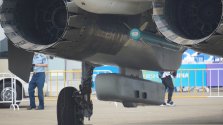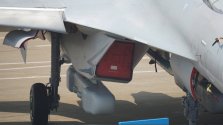Shi Liao× Shi Lao✓Shiliao and friend's twice a week talk show, now in the field from Zhuhai:
Here's the one from late last week where he and Yankee were talking about it based on photos coming out before the show:
For all the confusion between WZ-7 and WZ-9 here's the story: they are in fact one and the same. The plane was originally named WZ-9 then renamed to WZ-7. Even Shiliao made the mistake of calling it WZ-9 in last week's show. In today's show he corrected himself.
Shiliao considers WZ-7 and WZ-8 to be something very similar to cold war era recon aircraft (U-2 and D-21, both are very familiar to China) that are compromised design that sacrifice some spec to boost other areas due to technological limit. WZ-7 was limited by its engine (old J-7 turbojet) so its weird wing design was a compromised solution in order to achieve the very high altitude target. The wings look very scifi but if you think about it it's basically a biplane, and they need to be like that to squeeze as much lift out of them as possible for available engine power. Similarly WZ-8 needed to achieve very high speed and altitude and they said on well, liquid rocket engine then.
Just how high can WZ-7 fly? In last week's podcast Shiliao told a story about this he heard from PLAAF. One day a WZ-7 was flying in SCS and USN sent up a F/A-18 to shoo it away. The drone operator saw the super hornet get into position directly below it so that it could definitely be seen and then it did a roll and was flying inverted for a while. The drone operator being bewilder by this called his CO over to check it out and his CO said "you know what he's trying to do, he's trying to intimidate you with his load of missiles. But that's as high as his plane can fly so he could only show you by rolling over."
Shiliao said CH-7 is in the same role as WZ-7, only with technology having improved to such a degree that no compromise is required to achieve its goals any more.
As for J-16D they've gone up to it in close proximity and are certainly very impressed by it. It takes a while to just count all the antennas coming out of everywhere on this plane and then once you're done and you stand back a bit to take it all in you realise just how complex piece of kit it is. Shiliao have a friend in this field who's also familiar with Russian EW equipment and he's quoted as saying "no Russian could come up with a plane like J-16D, not in this life or the next!"
You are using an out of date browser. It may not display this or other websites correctly.
You should upgrade or use an alternative browser.
You should upgrade or use an alternative browser.
Zhuhai Air Show 2020
- Thread starter Deino
- Start date
Shiliao and friend's twice a week talk show, now in the field from Zhuhai:
Here's the one from late last week where he and Yankee were talking about it based on photos coming out before the show:
For all the confusion between WZ-7 and WZ-9 here's the story: they are in fact one and the same. The plane was originally named WZ-9 then renamed to WZ-7. Even Shiliao made the mistake of calling it WZ-9 in last week's show. In today's show he corrected himself.
Shiliao considers WZ-7 and WZ-8 to be something very similar to cold war era recon aircraft (U-2 and D-21, both are very familiar to China) that are compromised design that sacrifice some spec to boost other areas due to technological limit. WZ-7 was limited by its engine (old J-7 turbojet) so its weird wing design was a compromised solution in order to achieve the very high altitude target. The wings look very scifi but if you think about it it's basically a biplane, and they need to be like that to squeeze as much lift out of them as possible for available engine power. Similarly WZ-8 needed to achieve very high speed and altitude and they said on well, liquid rocket engine then.
Just how high can WZ-7 fly? In last week's podcast Shiliao told a story about this he heard from PLAAF. One day a WZ-7 was flying in SCS and USN sent up a F/A-18 to shoo it away. The drone operator saw the super hornet get into position directly below it so that it could definitely be seen and then it did a roll and was flying inverted for a while. The drone operator being bewilder by this called his CO over to check it out and his CO said "you know what he's trying to do, he's trying to intimidate you with his load of missiles. But that's as high as his plane can fly so he could only show you by rolling over."
Shiliao said CH-7 is in the same role as WZ-7, only with technology having improved to such a degree that no compromise is required to achieve its goals any more.
As for J-16D they've gone up to it in close proximity and are certainly very impressed by it. It takes a while to just count all the antennas coming out of everywhere on this plane and then once you're done and you stand back a bit to take it all in you realise just how complex piece of kit it is. Shiliao have a friend in this field who's also familiar with Russian EW equipment and he's quoted as saying "no Russian could come up with a plane like J-16D, not in this life or the next!"
Great summaries, thanks for the info. I don't want to pollute this thread but I must ask, what is going on with the CH-6.
The front half looks very low observable optimized but then it looks like it has these crappy engines stamped onto the back like it's a business jet. Are these engines considered outdated and did they not have the mastery to integrate stealthier ones, or was this a compromise made halfway through production when it was decided to go for a cheaper mass-produced model? It is a curious looking drone.

Great summaries, thanks for the info. I don't want to pollute this thread but I must ask, what is going on with the CH-6.
The front half looks very low observable optimized but then it looks like it has these crappy engines stamped onto the back like it's a business jet. Are these engines considered outdated and did they not have the mastery to integrate stealthier ones, or was this a compromise made halfway through production when it was decided to go for a cheaper mass-produced model? It is a curious looking drone.
View attachment 77671
It's not a VLO aircraft, and going for a twin engine design for the planform they chose, it is a fine configuration.
There are other drones with a similar configuration, perhaps of greatest similarity would be the BAE Mantis, which uses turboprops rather than jets.
CH-6 is not a VLO aircraft and doesn't require it's engines to be buried in the airframe.
Also, take a moment and think about what you're describing as "crappy". Do you really think the positioning of engines is the determinant of the quality of an engine?
Now, I suspect the engines on CH-6 are probably not particularly advanced given the state of China's overall aeroengine industry, but that has nothing to do with the positioning of the engine on the aircraft.
In short -- there's nothing wrong with it.
I don't know if there's been any word on just what model of an engine those are. That being said, their looks do support the idea that the engines are basically just whatever very small bypass ratio turbofan or even turbojet the maker had access to at a time. Perhaps some years into the future the model will receive better engines and then perhaps also receive a redesign of the nacelles. Who knows.
Even like this - in recon configuration the rcs might be comparable to a very small fighter. Or if its been treated with RA materials possibly even similar to a clean Superhornet.
Not sure if the whole project is something that PLAAF will buy and use. It could be the maker is mostly aiming at the almost same export market as Turkish Baykar with their Akinci drone.
Even like this - in recon configuration the rcs might be comparable to a very small fighter. Or if its been treated with RA materials possibly even similar to a clean Superhornet.
Not sure if the whole project is something that PLAAF will buy and use. It could be the maker is mostly aiming at the almost same export market as Turkish Baykar with their Akinci drone.
I don't know if there's been any word on just what model of an engine those are. That being said, their looks do support the idea that the engines are basically just whatever very small bypass ratio turbofan or even turbojet the maker had access to at a time. Perhaps some years into the future the model will receive better engines and then perhaps also receive a redesign of the nacelles. Who knows.
A redesign of the nacelles or a change of the engine type won't change what he had described as the basis for claiming the engines were "crappy" -- which was the positioning of the engines on the aircraft.
That part of my post was to point out that the positioning of the engines on the aircraft really should have no bearing on how capable or incapable the engines are, and frankly should not be a topic of interest on this UAV to begin with.
If they wanted a twin engine HALE UAV with this planform, there really are not many other ways they can configure the engines.
Either they put them at the tail m, or they put them under the wings (increasing the weight of the wings and reducing payload that the wings can accommodate), and on a HALE UAV it makes much more sense to out them at the tail.
It's not a VLO aircraft, and going for a twin engine design for the planform they chose, it is a fine configuration.
There are other drones with a similar configuration, perhaps of greatest similarity would be the BAE Mantis, which uses turboprops rather than jets.
CH-6 is not a VLO aircraft and doesn't require it's engines to be buried in the airframe.
Also, take a moment and think about what you're describing as "crappy". Do you really think the positioning of engines is the determinant of the quality of an engine?
Now, I suspect the engines on CH-6 are probably not particularly advanced given the state of China's overall aeroengine industry, but that has nothing to do with the positioning of the engine on the aircraft.
In short -- there's nothing wrong with it.
I guess I assumed that it was somewhat optimized for low observability in every area except the engine placement; of course you're correct in saying that engine placement (even if placed not ideally for low observability) would have nothing to do with the quality of the engines themselves.
To clarify and correct, do you think the placement of the engines is strange given the low observability aspect of the design everywhere else, or would you say it just doesn't even seem like it was meant to be somewhat low observable.
I guess I assumed that it was somewhat optimized for low observability in every area except the engine placement; of course you're correct in saying that engine placement (even if placed not ideally for low observability) would have nothing to do with the quality of the engines themselves.
To clarify and correct, do you think the placement of the engines is strange given the low observability aspect of the design everywhere else, or would you say it doesn't seem to have been that important for this design in the first place.
It's not that strange.
This is clearly not meant to be a VLO aircraft, it is LO at best, and the placement of its two engines is fine given its role.
Also, don't forget that in a mission where it is carrying an external payload it will have a larger RCS anyway.
Just take a step back, and consider what is really so different between the positioning of CH-6s engines compared to that of Global Hawk or WZ-7 (i.e. ignoring configuration of tails and wings).
Apart from the fact that CH-6 has two engines (therefore necessitating two nacelles), they are actually fairly similar. None of those aircraft have particularly buried engines nor S ducts, they are top mounted, and of course none of those aircraft are meant to be VLO.
Shiliao and friend's twice a week talk show, now in the field from Zhuhai:
Here's the one from late last week where he and Yankee were talking about it based on photos coming out before the show:
For all the confusion between WZ-7 and WZ-9 here's the story: they are in fact one and the same. The plane was originally named WZ-9 then renamed to WZ-7. Even Shiliao made the mistake of calling it WZ-9 in last week's show. In today's show he corrected himself.
Shiliao considers WZ-7 and WZ-8 to be something very similar to cold war era recon aircraft (U-2 and D-21, both are very familiar to China) that are compromised design that sacrifice some spec to boost other areas due to technological limit. WZ-7 was limited by its engine (old J-7 turbojet) so its weird wing design was a compromised solution in order to achieve the very high altitude target. The wings look very scifi but if you think about it it's basically a biplane, and they need to be like that to squeeze as much lift out of them as possible for available engine power. Similarly WZ-8 needed to achieve very high speed and altitude and they said on well, liquid rocket engine then.
Just how high can WZ-7 fly? In last week's podcast Shiliao told a story about this he heard from PLAAF. One day a WZ-7 was flying in SCS and USN sent up a F/A-18 to shoo it away. The drone operator saw the super hornet get into position directly below it so that it could definitely be seen and then it did a roll and was flying inverted for a while. The drone operator being bewilder by this called his CO over to check it out and his CO said "you know what he's trying to do, he's trying to intimidate you with his load of missiles. But that's as high as his plane can fly so he could only show you by rolling over."
Shiliao said CH-7 is in the same role as WZ-7, only with technology having improved to such a degree that no compromise is required to achieve its goals any more.
As for J-16D they've gone up to it in close proximity and are certainly very impressed by it. It takes a while to just count all the antennas coming out of everywhere on this plane and then once you're done and you stand back a bit to take it all in you realise just how complex piece of kit it is. Shiliao have a friend in this field who's also familiar with Russian EW equipment and he's quoted as saying "no Russian could come up with a plane like J-16D, not in this life or the next!"
Interesting.
Did we know previously that the WZ-7 used a variant of the WP-13 (Russian R-13) from the J-7/Mig-21 Sino Fishbed?
WP-13 and J-7 can fly up to around 17,000m service ceiling while the F-18 is around 15,000m service ceiling so that makes sense BUT the fact that the F-18 pilot was "directly underneath" when rolling over to show missiles is not necessarily because it was at service ceiling? I mean 1. It was "directly under" and 2. it would want to do that roll under the drone since the camera which the operator uses is pointing in that direction so it makes sense for the "I'm weapons loaded" roll to be done in this position. If it were done hundreds of metres below as "directly under" then maybe.
Anyway there is high likelihood that the PLA knows what the real service ceilings for F-18s are and no doubt would try to fly recon drones above if they don't like being hassled.
It also doesn't make much sense for the F-18 to bother with a warning. They aren't going to shoot at the drone during peacetime and can simply move away or attempt to not allow the drone to collect any sensitive information.
As for the J-16D. It does look mighty impressive. Quite a leap from the older J-15D and J-16D prototypes leaked years ago. The J-16 platform really makes the perfect EW dedicated aircraft - fast and a lot of power produced. Internal changes probably brimming with new auxiliary power units.
Looks like practice rounds, which makes sense since they are not gonna leave live ammo tethered to an aircraft, in the open, for days on end.



